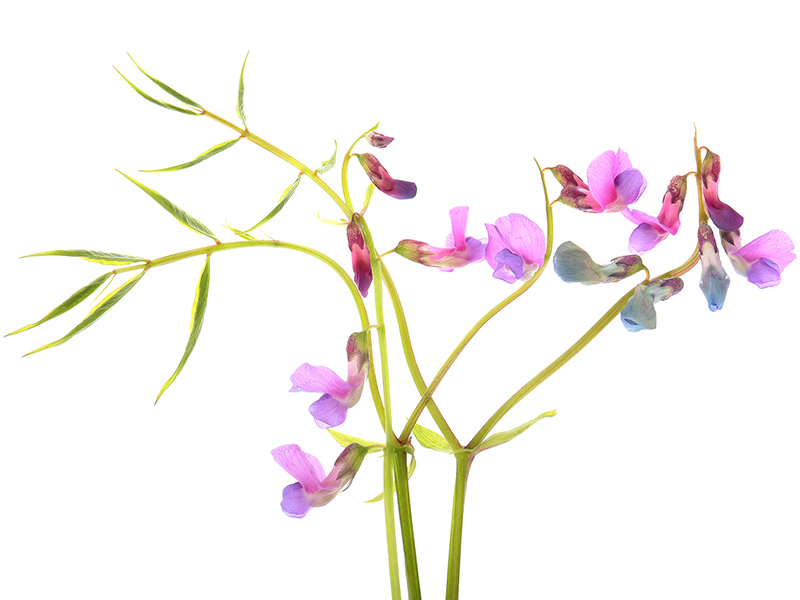The spring vetchling or spring pea (Lathyrus vernus) is one of those plants that needs to be seen up close to appreciate its loveliness.
It’s a relative of the sweet pea, but is far smaller and looks much more delicate. It doesn’t climb, but instead produces a rounded clump of leaves and flowers around 18 inches high and wide. The flowers are just 3/4 inch long.
Several different cultivars of Lathyrus vernus have been bred to give different flower colours. You can find plants with flowers in pink and white, plain pale pink, white or blue. The plant in my photographs is the original species.
These flowers start out purplish pink, but gradually age to a pale blue. This gives a range of different shades of colour which adds to the appeal for photography. In those areas where background flowers are out of focus, the colours have a softness that reminds me of watercolour paint (top photo).
While writing this, I have popped back into my studio and had a quick look at the flowers in their vase. I was delighted to discover that the flowers have continued to change colour even after picking. The remaining flowers are now almost all blue, so I should be able to take some quite different photographs of them. (In that case, next week’s post will probably be blue spring flowers.)
The spring pea’s flowers are amongst my favourites at this time of year. For me, the smallest flowers can be the prettiest.


Love the tiny buds – they do have a strange name though! The Spring Vetchlings actually do look quite painterly. I think it is interesting they change color as they age – I wonder why the plant developed this trait. Very nice
LikeLiked by 1 person
I wonder if it’s the loss of the pink colouring as they age – a bit like humans going grey! (And I’ve noticed that as my cats age, their black fur starts to go gingery, while the white areas stay white.) Whatever the reason, it makes the photography more interesting. 🙂
LikeLiked by 1 person
I often wonder about the plant world – there has to be a lot of similarities. And no question about our fur babies – Sophie is too young at this point but I will be watching!
LikeLiked by 1 person
We have several vetches, and they’re all lovely. I must admit I first read your title as ‘spring kvetching.’ I doubt there’s any connection between the words, since ‘kvetch’ is Yiddish, but you never know. What I do know is that these are especially pretty, and your photo’s delightful!
LikeLiked by 1 person
Nope — no connection at all between the words. So much for folk etymology!
LikeLiked by 1 person
You made me laugh! I can see why you misread it – and with the cold weather we’ve had, it could be very appropriate! 🙂
LikeLike
Your vetchling is much lovelier than what is called vetch here. The one I see most often is called cow vetch-Vicia cracca, is non-native, and is a bit of a nuisance although the bees love it.
LikeLiked by 1 person
We do have several pretty wildflowers with pea-type flowers, e.g. common vetch and bird’s foot trefoil. There seemed to be lots of them around when I was a kid and I think they were amongst the first flowers I was aware of – lovely little things!
LikeLiked by 1 person
Many flowers change colour as they age, so there must be a reason for it. Perhaps to help pollinators know if it worth visiting? I agree that the colour combination is very alluring.
LikeLiked by 1 person
Aha, Susan – what a good point! It must be helpful to pollinators to be able to see quickly that a flower is old. And it makes sense for the plant to be steering the bees away from the flowers that are already pollinated, so that they are more likely to visit unpollinated flowers. I think you have probably cracked that one! 🙂
LikeLike
Not actually heard of vetchling or seen this small pretty sweet pea like plant. Do they smell like sweet peas?
LikeLiked by 1 person
They look just like tiny sweet peas but sadly don’t smell like them…would be wonderful if they did! 🙂 (Mind you, my sense of smell isn’t brilliant, so it’s always possible that there’s a very slight scent…)
LikeLiked by 1 person
[…] You can see my post with the spring peas still in their original pinks and purples here. […]
LikeLike
[…] mentioned flower colour change in previous posts: Lathyrus vernus (spring vetchling or spring pea) changes colour in the same way, going from a pale magenta-pink to […]
LikeLike